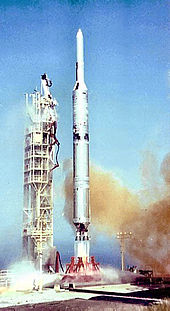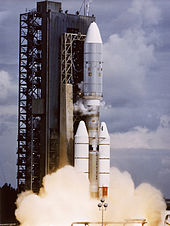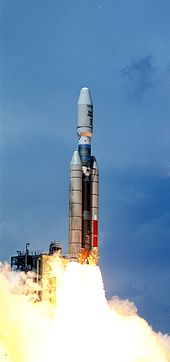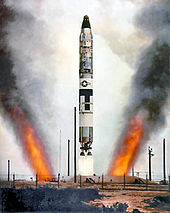Titan (launcher)
The Titan missile was originally built as a military ICBM by Martin Marietta . However, it later found its main use as a launch vehicle in space travel. The Titan was actually designed by the USA to replace the Atlas intercontinental ballistic missile. A whole family of ICBMs and launch vehicles was created through various modifications.
Titan I, II and Titan II Gemini
Development of the Titan I began in 1955. Due to its lack of reliability and the lengthy take-off preparations, it was unsuitable as a counter-strike weapon. (For security reasons, had the rocket before the launch from the silo down, be otherwise explosion danger existed through the evaporating oxidizer oxygen.) Therefore During the testing of the Titan I Titan II was begun to develop that (due to the fuel combination nitrogen tetroxide / Aerozin 50 ) could start from silos without any problems. Titan II were part of the US land-based strategic ICBM arsenal from 1963 to 1987. This heaviest American ICBM system ever used , intended to destroy the most heavily bunkered Soviet facilities, carried a Mk-6 / W53 warhead (9 MT). In the 1970s, 54 rockets (37 in 1984) were stationed at three SAC bases in Arizona , Kansas and Arkansas .
In addition to the military , NASA took an early interest in the rocket. In November 1963 (while it was still in development) it selected the Titan II as the carrier for the two-seater Gemini spacecraft , as no other carrier could carry such a payload (3.6 t) at that time . In a modified form, it also served as a carrier for various unmanned military satellites. The last Titan II (variant Titan 23G) launched a military weather satellite in 2003.
Titan III
Titan IIIA, IIIB, 34B

As a further development of the Titan II, a launch vehicle was developed for the US Air Force from 1962 , which had an additional third stage. This variant, the Titan IIIA (with the "Transtage" upper stage), did not get beyond the testing stage. The Titan IIIB (with Agena-D as the upper level) became much more successful . It was used in large numbers to launch spy satellites that were designed for launch with the Agena and had to use them. In the mid-1970s, the two stages of the Titan III were further improved and lengthened to accommodate more fuel, creating the Titan 34B with Agena upper stage.
Titan IIIC and IIID
The next leap in development was the Titan IIIC, which had a significantly higher payload (> 12 t in low orbits) thanks to two large solid boosters attached to the side and modified first stages. In contrast to all other rockets, the first stage was not ignited together with the boosters, but only shortly before they burned out. The boosters of the Titan IIIC to IVB missiles thus represented a two-part stage upstream of the previous first stage. Because the designation of the previous stages was not wanted, the boosters were called the "zeroth stage". The Titan missiles were therefore bundle and not parallel stage missiles. The Titan IIIC used the Transtage as an upper level and was used from 1965. It could put satellites directly into geostationary orbits.
This was followed by the Titan IIID (IIIC without upper level from 1971) for the launch of spy satellites into low orbits.
Titan IIIE / Centaur

The Titan IIIE variant was developed for NASA. This used a slightly modified Centaur version of the Atlas Centaur as the upper level. The Centaur was housed in the new, voluminous payload fairing on the Titan IIIE . The Centaur upper stage used a more energetic fuel combination than the Transtage, so its payload for high orbits was significantly greater than that of the Titan IIIC. NASA used them in 1974–1977 to launch the Helios , Viking and Voyager 1 and Voyager 2 space probes . It could put 15 t in low orbit, 3.4 t in geostationary orbit, and 1.5 t in an escape orbit to Jupiter.
Titanium 34D
After that, the Titan should be detached from the space shuttle . However, since the shuttle program was delayed and heavy loads still had to be transported into orbit , the Titan 34D was developed. It was a combination of the extended first two stages of the Titan 34B and extended solid boosters. In addition to the Transtage, she could also use the IUS as a third stage. It had its first launch on October 30, 1982 and was able to put 14.5 t into low orbit.
Parallel developments

Titanium 23G
In 1986, Martin Marietta Corporation was commissioned to convert the retired Titan II ICBMs into launch vehicles. For this purpose, the launch facilities of the Titan IIIB in Vandenberg were modified; In addition, the navigation systems of the Titan II rocket were improved and it received a new payload fairing. The resulting rocket was named Titan 23G. The first launch took place on September 5, 1988. After a total of 13 launches, the Titan 23G program was ended on October 18, 2003 with the last launch of a rocket.
Titan III / Commercial
The manufacturer Martin Marietta also tried to offer the Titan commercially on the satellite launch market. In addition, the Commercial Titan III was created, which had a few modifications in the first and second stages as well as a new, voluminous payload fairing. Otherwise it corresponded to a Titan 34D. It could be started in connection with various advanced levels. The first flight took place on January 1, 1990. After a further three flights, however, the rocket's production was discontinued because it was too expensive and therefore not commercially competitive.
Titan IV
Titan IVA

But even after the successful start of the shuttle program, the days of the Titan were not numbered. The Titan IV was put into planning due to delays in the start and even more so due to the Challenger disaster . On June 14, 1989, the new rocket took off on its maiden flight . It was even larger and heavier than the Titan III and 34D and could thus carry almost 18 t into a low orbit. In conjunction with an improved Centaur upper stage, Titan IV was able to bring up to 4.5 t into a geostationary orbit.
Titan IVB
The final stage of the program is the Titan IVB. It was designed as a carrier for particularly heavy loads and differs from the Titan IVA in that it is larger, more powerful, modern solid matter booster with swiveling thrusters. (The boosters on the Titan IIIC-IVA had rigid thrusters; they were controlled by injecting nitrogen tetroxide into the boosters from a separate tank for thrust vector control.) This enabled them to deliver 21 t in a low and 5.5 t in a geostationary Orbit. It took off for the first time on February 23, 1997. On its second flight, the Titan IVB in conjunction with a Centaur upper stage brought the Cassini-Huygens space probe on its way to Saturn . This was also the only non-military use of a Titan IV.
End of the Titan program
The last launch of a Titan IVB from Cape Canaveral took place on April 30, 2005. The final launch of a Titan IV rocket and thus the entire Titan program took place on October 19, 2005 from Vandenberg . The extremely expensive Titan IVB was replaced by the more modern and significantly cheaper Delta IV Heavy and Atlas V missiles . At the start of Cassini-Huygens , a starting price of 433 million US dollars was mentioned , which is said to have been significantly exceeded later.
| Type | Total number | Starting place | |
|---|---|---|---|
| Cape Canaveral number (launch pad) |
Vandenberg number (launch pad) |
||
| Titan I ICBM | 67 | 47 ( 15 , 16 , 19 , 20 ) | 20 ( LC-395-A , SLTF ) |
| Titan II ICBM | 81 | 23 (15, 16) | 58 ( LC-395-B, -C, -D ) |
| Titan II launch vehicles | 25th | 12 Titan Gemini (19) | 13 Titan 23G missiles ( SLC-4W ) |
| Titan IIIA | 4th | 4 (20) | - |
| Titan IIIB | 57 | - | 57 (SLC-4) |
| Titan IIIC | 36 | 36 ( 40 , 41 ) | - |
| Titan IIID | 22nd | - | 22 (SLC-4) |
| Titanium 34B | 11 | - | 11 (SLC-4) |
| Titan IIIE | 7th | 7 (41) | - |
| Titanium 34D | 15th | 8 (40) | 7 (SLC-4) |
| Commercial titanium | 4th | 4 (40) | - |
| Titan IVA | 22nd | 14 (40, 41) | 8 (SLC-4) |
| Titan IVB | 17th | 13 (40, 41) | 4 (SLC-4) |
| total | 368 | 168 | 200 |
Table of the main titanium versions
| Dates / versions → | Titan II | Titan III (Titan IIIA) | Titan IIIE Centaur | Titan IVA | Titan IVB |
|---|---|---|---|---|---|
| First flight | April 8, 1964 | 2nd September 1964 | February 11, 1974 | June 4th 1989 | February 23, 1997 |
| Last flight | October 18, 2003 | September 25, 1992 | 5th September 1977 | August 12, 1998 | October 19, 2005 |
| Full mass (fueled) | 151 t (137 t) | 173 t (158 t) | 632 t | 860 t (733 t) | 924 t (811 t) |
| Payload LEO | 3.8 t | 3.5 t | 15.4 t | 17.7 t | 21.7 t (5.7 t GEO ) |
| height | 32 m | 37.8 m | 48 m | 50 m | 51 m |
| Payload fairing diameter | 3.05 m |
4.27 m |
Max. 5.1 m
|
||
| Start thrust | 1,912 kN | 1,941 kN | 8,900 kN | 11,230 kN | 13,531 kN |
| fuel |
H 2 / O 2 , aerozin 50 / N 2 O 4 , solid |
Aerozin 50 / N 2 O 4 , solid |
Aerozin 50 / N 2 O 4 , solid ( HTPB ) |
||
See also
Trivia
In the television series Stargate Kommando SG-1, the Stargate stands in a fictional former underground rocket silo for the Titan (rocket), which the protagonists visit in the 21st episode "1969" of the second season.
In Star Trek: First Contact in 2063, a Titan V rocket is used to launch humanity's first warp-capable spaceship, the Phoenix, into space.
Web links
- The Titan I and II missiles
- The Titan III and IV missiles
- Information about Titan ( Memento from June 16, 2010 in the Internet Archive )
- Titan variants and start lists (English)
- Titan Missile Museum in Arizona (English)
- Norbert Bruges: Titan Family (German / English)
Individual evidence
- ↑ Bernd Leitenberger: Die Titan 3 und 4. Retrieved on September 15, 2013 .
- ^ Norbert Bruges: Martin Marietta Aerospace Corp. / USAF, Titan 3. Space Launch Vehicles - all of the world. Norbert Brugge, b14643.de, accessed on September 15, 2013 .




